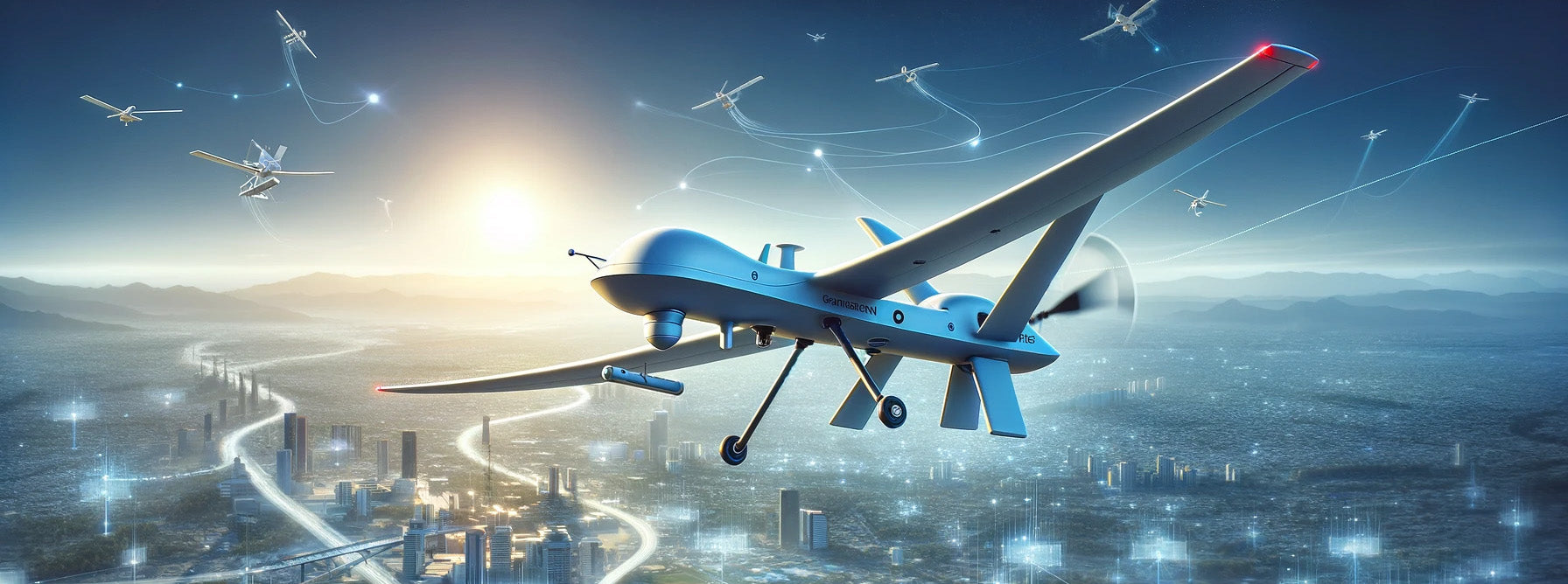
Autonomous Systems and Satellite Networks
- 14 Mar, 2024
- Posted by: Michael Mathison
Autonomous Systems and Satellite Networks
Satellite networks play a transformative role in the deployment and operation of autonomous systems, providing the critical communication and data services these systems rely on to function effectively. From autonomous vehicles navigating sprawling urban landscapes to drones conducting environmental monitoring in remote areas, satellite networks offer the global coverage, reliability, and precision required for these technologies to operate seamlessly.
By enabling real-time data transmission, precise positioning, and uninterrupted connectivity, satellite networks ensure that autonomous systems can perform a wide range of tasks more efficiently and safely, regardless of their location. This integration of satellite technology is pivotal in advancing the capabilities of autonomous systems, driving innovation across industries, and shaping the future of automation and machine intelligence.

UAV
Unmanned Aerial Vehicles (UAVs), as a key component of autonomous systems, are significantly influenced by satellite networks, which enhance their capabilities, extend their operational range, and increase their utility across various applications. Here’s how:
Explanation:
Satellite networks provide the essential connectivity UAVs require for navigation, communication, and data transfer, especially in remote or hard-to-reach areas where traditional communication systems are unavailable or unreliable. This connectivity supports not only basic flight operations but also advanced applications such as real-time surveillance, environmental monitoring, and precision agriculture. By leveraging satellite technology,
UAVs can operate beyond visual line of sight (BVLOS), enabling them to undertake longer and more complex missions. Furthermore, satellite networks facilitate the integration of UAVs into the broader airspace management systems, ensuring safe and efficient operations alongside manned aircraft. This integration is crucial for expanding the commercial and public service applications of UAVs.
How UAVs in Autonomous Systems are Affected by Satellite Networks:
-
Enhanced Navigation and Positioning: Satellite networks provide accurate GPS data, essential for the precise navigation of UAVs.
-
Beyond Visual Line of Sight (BVLOS) Operations: Enable UAVs to safely operate beyond the visual line of sight, significantly extending their range and utility.
-
Real-time Data Transmission: Facilitate the immediate transfer of data and imagery from UAVs to users or control centers, essential for applications like surveillance and environmental monitoring.
-
Improved Communication: Ensure reliable communication between UAVs and control stations, critical for managing operations and responding to changing conditions.
-
Increased Operational Safety: Support advanced collision avoidance systems and airspace management, increasing the safety of UAV operations.
-
Global Reach: Provide connectivity in remote areas, expanding the potential use cases for UAVs in industries like oil and gas, mining, and scientific research.
-
Disaster Response and Emergency Services: Enable UAVs to quickly and safely assess disaster zones, support search and rescue operations, and deliver emergency supplies.
-
Precision Agriculture: Support precision agriculture practices by enabling real-time monitoring and data collection on crop health, moisture levels, and more.
-
Environmental Monitoring: Allow for the continuous monitoring of environmental conditions, wildlife, and changes in ecosystems, contributing to conservation efforts.
-
Infrastructure Inspection: Facilitate the inspection and monitoring of critical infrastructure, such as pipelines, power lines, and bridges, enhancing maintenance efficiency and safety.
Satellite networks thus significantly enhance the capabilities and applications of UAVs within autonomous systems, enabling these devices to perform a wide range of tasks more efficiently, safely, and effectively, with a global reach that was previously unattainable.

Autonomous Vehicles
Satellite networks profoundly impact the operation and development of autonomous vehicles (AVs), providing essential services that enhance navigation, safety, and connectivity. These networks enable AVs to access a broader range of data and maintain constant communication with control centers, other vehicles, and infrastructure, crucial for their autonomous operations. Here’s how:
Explanation:
For autonomous vehicles to navigate safely and efficiently, they require precise, real-time information on their environment and status. Satellite networks offer global positioning services (GPS) that provide the foundational data for AV navigation systems. Beyond positioning, these networks facilitate the transmission of vast amounts of data necessary for the vehicles to understand traffic conditions, weather updates, and road hazards.
Satellite communication also plays a crucial role in vehicle-to-everything (V2X) communications, enabling AVs to interact with other vehicles, pedestrian devices, and the road infrastructure to make informed decisions. This level of connectivity and data exchange is essential for the seamless integration of autonomous vehicles into the broader transportation ecosystem, ensuring their reliable performance in diverse conditions and environments.
How Autonomous Vehicles are Affected by Satellite Networks:
-
Enhanced Navigation and Positioning: Satellite GPS provides the critical location and timing information necessary for precise navigation.
-
Real-Time Traffic and Weather Updates: AVs can access updates on traffic conditions and weather, allowing for dynamic route adjustments to avoid congestion and hazardous driving conditions.
-
Improved Connectivity: Constant satellite communication ensures that AVs remain connected for operational control, data exchange, and emergency communications, even in remote areas.
-
Vehicle-to-Everything (V2X) Communications: Supports the exchange of safety and operational data between AVs, infrastructure, and other road users, enhancing road safety and traffic efficiency.
-
Data Transmission: Enables the high-speed transmission of sensor data and telematics to cloud-based platforms for processing and analysis, supporting the AV's decision-making processes.
-
Remote Monitoring and Management: Fleet operators can monitor and manage AVs remotely, adjusting to operational demands and ensuring maintenance needs are met.
-
Cybersecurity: Satellite networks facilitate secure communication channels for AVs, protecting them from cyber threats and ensuring the integrity of transmitted data.
-
Global Operations: Facilitate the expansion of AV operations internationally, providing consistent navigation and communication capabilities across borders.
-
Emergency Response: In case of system failures or accidents, AVs can utilize satellite networks to alert emergency services and provide precise location information.
-
Software Updates and Maintenance: Allow for the remote updating of vehicle software, ensuring that AVs operate with the latest features and security measures.
Satellite networks are integral to the functionality and advancement of autonomous vehicles, offering the connectivity and data capabilities required to navigate safely, interact with their surroundings, and integrate into the global transportation network. These technologies ensure that AVs can operate more efficiently and securely, marking a significant step forward in the evolution of autonomous transportation.

Autonomous Vessels
Satellite networks have a profound impact on autonomous vessels, transforming maritime operations by enhancing navigation, communication, and safety. These networks are essential for the efficient and reliable functioning of unmanned ships, extending their operational capabilities and enabling them to undertake complex missions across the globe's oceans. Here’s how:
Explanation:
Autonomous vessels rely on satellite networks for precise global positioning and navigation, crucial for plotting courses and avoiding hazards without human intervention. These networks also facilitate real-time communication with shore-based control centers, allowing for remote monitoring, command, and intervention when necessary. Satellite technology supports the transmission of vast amounts of data, including weather information, sea conditions, and maritime traffic, all of which are essential for the safe operation of autonomous vessels.
Moreover, satellite connectivity is vital for implementing collision avoidance systems and ensuring compliance with international maritime regulations. By leveraging satellite networks, autonomous vessels can operate more efficiently, safely, and sustainably, revolutionizing the maritime industry and its approach to shipping, exploration, and environmental monitoring.
How Autonomous Vessels are Affected by Satellite Networks:
-
Global Navigation and Positioning: Enables precise navigation and positioning, critical for autonomous operation and route planning.
-
Real-Time Communication: Facilitates constant communication with shore-based control centers, essential for operational oversight and remote decision-making.
-
Data Transmission: Supports the transmission of sensor data, weather updates, and other vital information, ensuring autonomous vessels can adapt to changing conditions.
-
Collision Avoidance: Satellite networks enable vessel-to-vessel and vessel-to-infrastructure communication, crucial for implementing collision avoidance systems.
-
Remote Monitoring: Allows for the continuous monitoring of vessel health, performance, and location, ensuring operational safety and efficiency.
-
Emergency Response: Enables rapid communication in emergencies, allowing for timely coordination of rescue operations or remote troubleshooting.
-
Regulatory Compliance: Facilitates electronic reporting and compliance with maritime regulations, including international shipping and environmental standards.
-
Weather Forecasting: Provides access to accurate and timely weather forecasts, enabling vessels to navigate safely and avoid severe weather.
-
Fleet Management: Supports the management of autonomous vessel fleets, optimizing logistics and reducing operational costs.
-
Environmental Monitoring: Enables autonomous vessels to participate in environmental monitoring and data collection, contributing to scientific research and conservation efforts.
Satellite networks are indispensable to the development and operation of autonomous vessels, offering the connectivity and data capabilities necessary for these advanced maritime platforms to navigate safely and perform their missions effectively. This technology not only enhances the capabilities of autonomous vessels but also promises to drive innovation and sustainability in the maritime industry.








